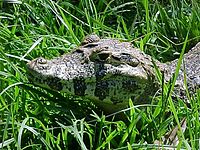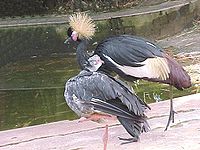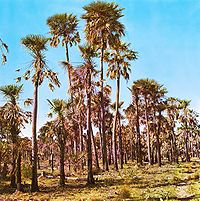- Chaco (Paraguay)
-
Main article: Gran Chaco
The Paraguayan Chaco or Región Occidental (Western Region) is a semi-arid region in Paraguay, with a very low population density[citation needed].
The Chaco is a large geographic area that is sparsely populated. Many of those living in the region are native peoples. It covers the departments of Boquerón, Upper Paraguay and the Department of Presidente Hayes, Paraguay.
Chaco was the scene of the most recent territorial war to occur in South America; an armed conflict between Paraguay and Bolivia, lasting from 1932-1935.
The region is also home to sites of historical significance that have been preserved, including Boquerón, Campo Grande, Via Campo, Nanawa, the site of the battle of Cañada Strongest, Carmen, Kilometro 7, Picuiba, and Villamontes, amongst others.
Contents
Location
Chaco is located between the Pilcomayo and Paraguay rivers, which provide saline soils that attract a rich variety of plants and animals. Its boundaries are the border with Argentina along the Pilcomayo River to the west; the border with Brazil over the mouth of Apa River to the south-east; is the border with Bolivia to the north; and the border with the Región Oriental (Eastern Region) to the south.
Animals
The Chaco has an abundance of wildlife. Larger animals present in the region include jaguar, ocelot, puma, tapir, giant armadillo, spiny anteater, many species of foxes, numerous small wildcats, the agouti (a large rodent), the capybara (water hog), the maned wolf, the palustrian deer, the peccary and the guanaco (a camelid related to the llama). The Chaco is one of the last major refuges of the rhea (or nandu), a large flightless South American bird. The region has an abundant and varied bird population. The streams host more than 400 fish species, among which are the salmon-like dorado and the flesh-eating piranha. The region is home to many species of insects, some of which cause discomfort for travellers. Reptiles also are abundant, with numerous lizards and at least 60 known species of snakes, including many pit vipers and constrictors. At least 6 species of poisonous tree toads have been identified.
Flora
The vegetation of the Chaco varies from the east to the west, reflecting the changing nature of the soil. Eastern Chaco is noted for its park-like landscape of clustered trees and shrubs interspersed with tall, herbaceous savannahs. To the west, a wide transition zone grades into the espinal, a dry forest of spiny, thorny shrubs and low trees. Chaco's vegetation has adapted to grow in arid conditions, and is highly varied and exceedingly complex. One of the most impressive vegetation formations is called the quebrachales, which consists of vast, low hardwood forests where various species of quebracho trees are dominant. The quebracho tree is economically important as a source of tannin and lumber. These forests cover extensive areas away from the rivers; nearer the rivers they occupy the higher, better-drained sites, giving rise to a landscape in which the forests appear as islands amid a sea of savannah grasses growing as high as a person on horseback. In the more arid western Chaco, thorn forests, the continuity of which is occasionally broken by palm groves, saline steppes, and savannas, created by fire or deforestation, are dominated by another quebracho tree that has a lower tannin content and is used most often for lumber. There is also a marked increase in the number and density of thorny species, among which the notorious vinal (Prosopis ruscifolia) was declared a national plague in Argentina because of how its thorns, up to a foot in length, posed a livestock hazard in the agricultural lands it invaded.
Main features
Main article: Gran ChacoEcotourism remains a potential industry for the region because of its rich biodiversity, allowing for a similar type of ecotourism seen in the Amazon.
The region remains of interest to hunting enthusiasts. It also hosts the annual Trans Chaco Rally, a prominent automobile race, which is considered one of the most difficult the continent[by whom?], mainly because of the dusty and dry roads which comprise its routes, and the extreme heat.
Chaco is known for its cultural, religious and economic diversity. The indigenous people of Chaco maintain their customs, and this is particularly prominent in northern Chaco. Northern Chaco is also known as an ideal place to purchase indigenous fine crafts. In the forest reserves, the languages native languages Sanapaná and Nivakle are spoken by the locals.
The karanda'y is the material used for the manufacture of handbags, wallets, vases, porta tereré (bags to hold thermos flasks for tereré, the typical summer drink) carrying baskets and mats. The natives are experts in natural medicine. The thorny varieties of plants are replacing the trees with deciduous leaves in these areas.
Chaco also offers an excellent option for rural tourism. One place offering rural tourism opportunities is the area Estancia La Patria, Department of Boquerón, Colony Neuland, which was created by the national government with the aim of boosting the development of this area of the country. It is located 110 kilometers from Infante Rivarola, a military post located on the border with Bolivia.
The Chaco area is famous for the large number of hunters who visit, despite a ban on hunting of endangered animals.
It is a high floodplain with a gentle slope to the east, and experiences relatively little rainfall (400 mm/year). Some areas are flooded occasionally, during which time the appearance of species adapted to such an environment is seen. The soils in the region are salty, and their use is limited because of their aridity. The Chaco is irrigated by the rivers Pilcomayo and Paraguay, both of which sproutmany tributaries.
National parks
- National Park Defensores del Chaco - 7800 km²
- National Park Tinfunqué - 2800 km²
- National Park Teniente Enciso - 400 km²
Main cities
Filadelfia is of great importance to the region's economy, mainly because of its lucrative dairies.
Tribes and their locations
The language families and their locations are as follows:
- Language family Maskoy Toba; on the Paraguay River in central-east.
- The language family Mataco Nivaclé; near the Pilcomayo River in the south-east.
- The language family Zamuco, Chamacoco; on the Paraguay River in north-east.
- The language family guaicurúes emake; in the lower Chaco.
Notes
References
- La magia de mi Tierra. Fundación en Alianza. 2007
External links
See also
- Chaco (disambiguation)
- Departments of Bolivia
- Departments of Paraguay
Categories:- Divided regions
- 1992 disestablishments
- Subdivisions of Paraguay
Wikimedia Foundation. 2010.




